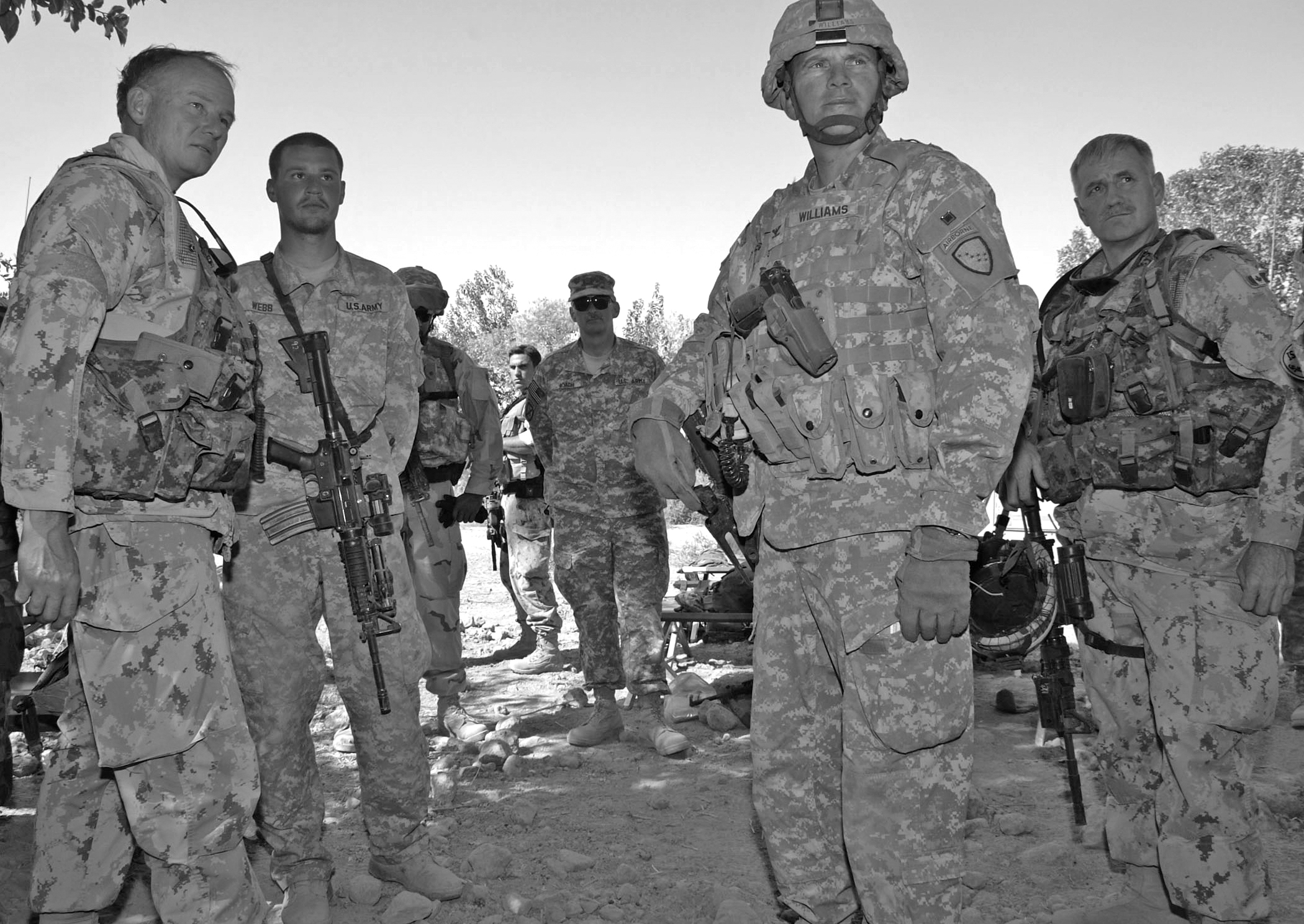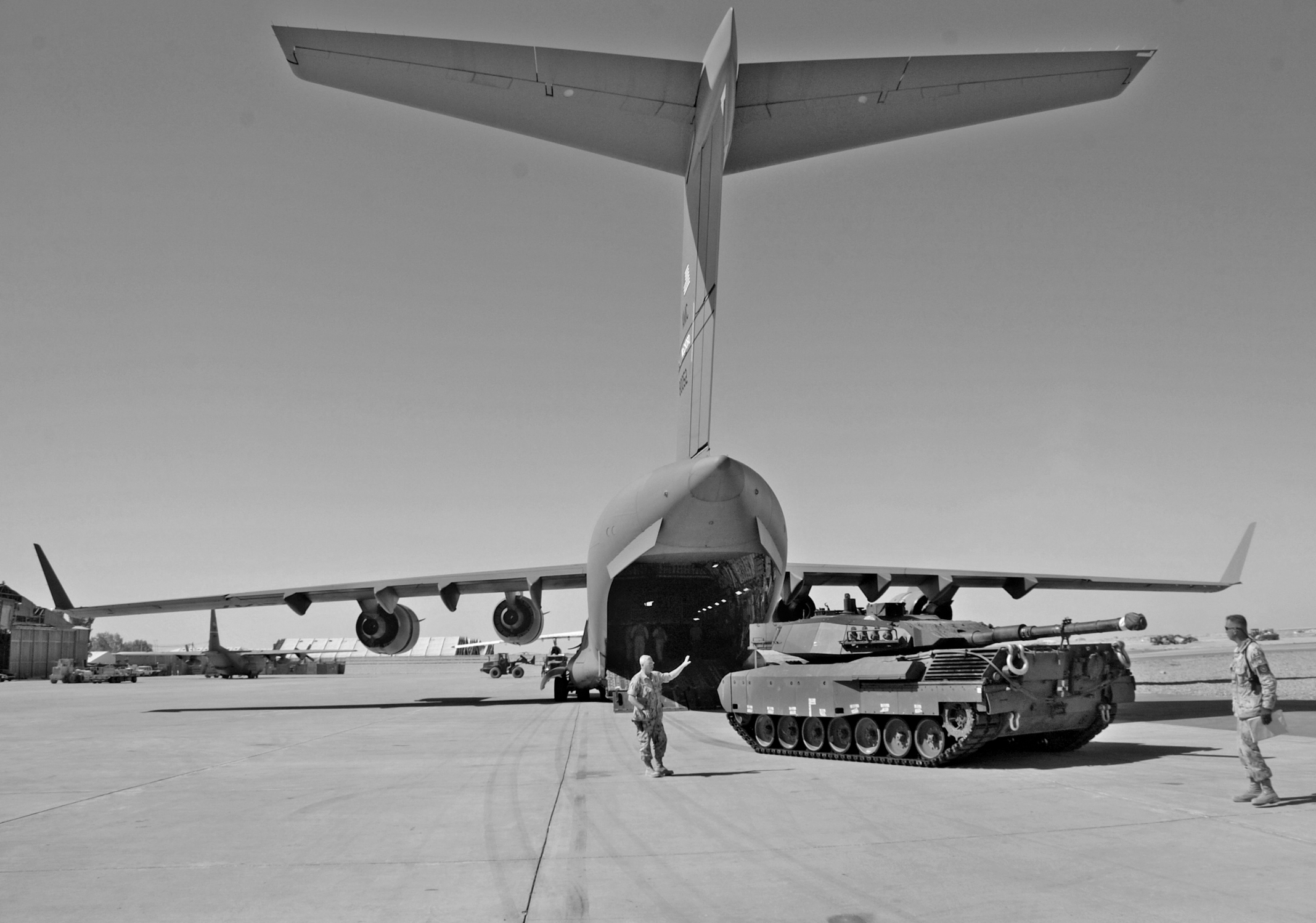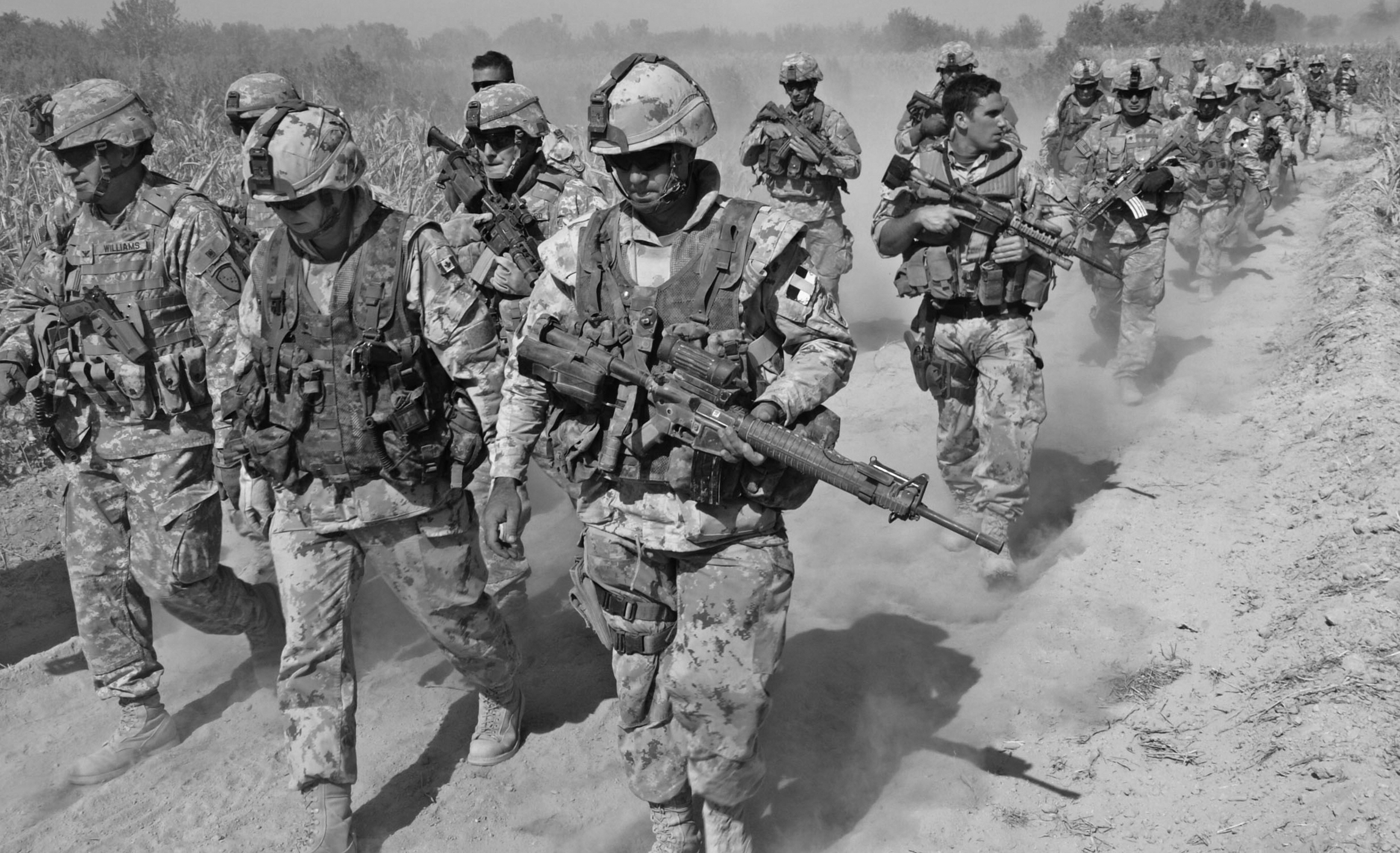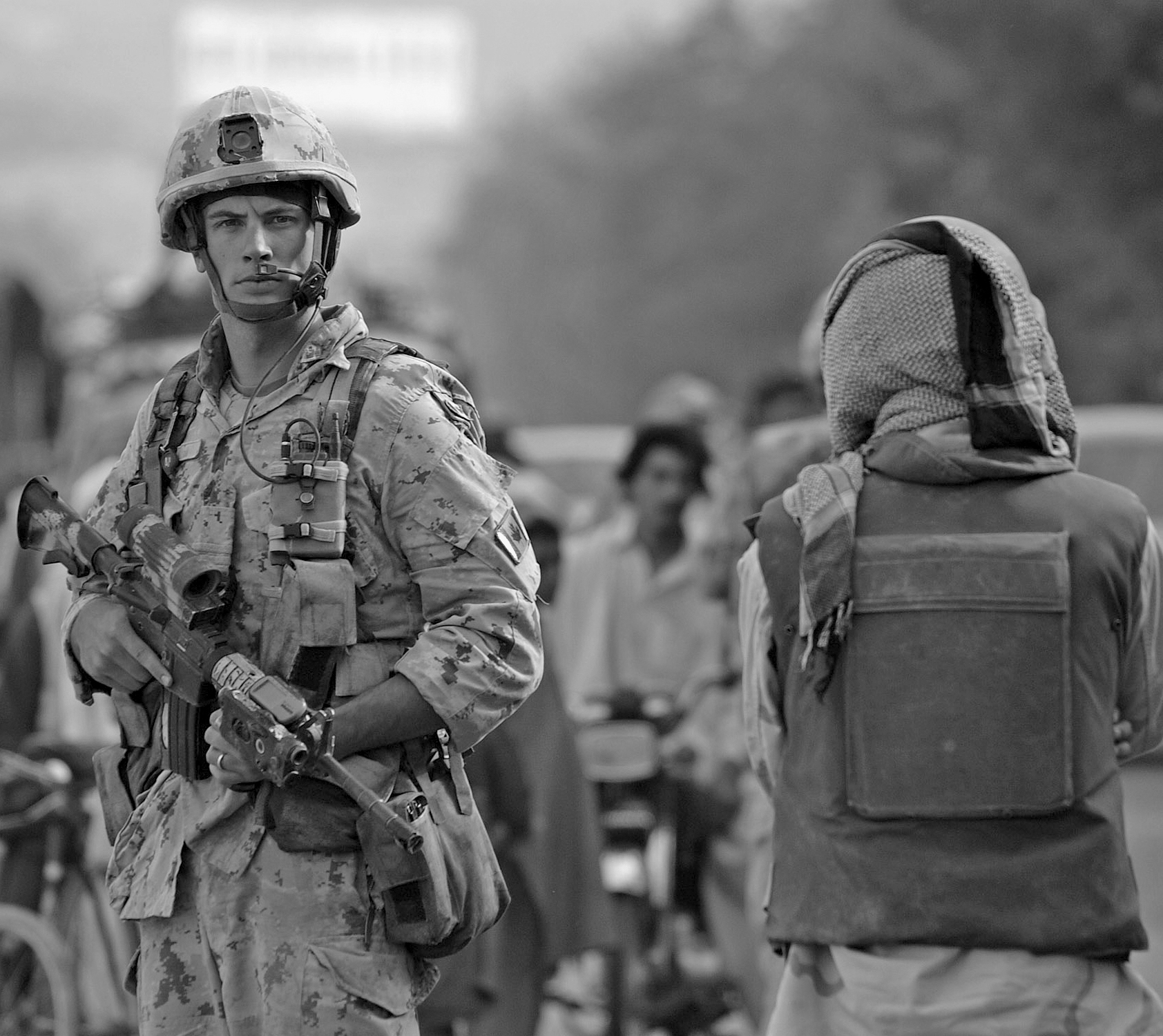CHAPTER 19
CONCLUDE
I have survivor’s guilt, of course. We all do. My shrink—a little firecracker about this tall—says, “You fucking Army guys. (That’s the way she talks.) You’re all pressure cookers. Flip, flip, flip then BANG, you explode.”
MOTHER
Rewind to September 4 at M’sūm Ghar. After friendly fire had stopped Charles Company on its way back into Objective Rugby, we had to rethink the plan. Both our strategy and configuration would have to change. We needed a fresh approach.
Charles Company was combat ineffective for the moment. They needed time to regroup. 1 RCR needed a new look at the situation, and we discussed our options. It was agreed that we would move Task Force 3-06 from the south up to Patrol Base Wilson where we would attack the enemy from the north. This had not been our chosen course of action at the beginning, because it would expose 1 RCR to the full strength of the enemy position and require them to fight through terrain and huts and buildings that favoured the defender. But after recent events we had no alternative.
Major Geoff Abthorpe and Bravo Company had already been sent via Highway 1 to take a position north of the Taliban defences. Their task was to patrol the edges of the battlespace, act as a northern screen and feint down onto objectives Cricket and Lacrosse to distract the enemy as Charles Company (in the original plan) went in to secure Rugby. Engineers from 23 Field Squadron went with them to clear routes and create new roads as needed.
Bravo’s first action was to work its way over to a sub-objective known as the “yellow school.” The Taliban had been using the location to stage attacks on a section of the route between Kandahar Airfield and Patrol Base Wilson, a stretch we had all learned to call Ambush Alley. From there they were firing rockets and mortars onto Wilson itself. A host of Canadian reporters, many of whom filed their stories from Wilson’s internet tent, had seen the impact of the attacks. Wilson was in rough shape.
At the yellow school, Bravo Company was immediately engaged. They returned fire in force, overwhelming the enemy within minutes. The feint had been a success, with the enemy drawn out and destroyed. The company then slowed down to maintain its holding pattern just above Objective Cricket, which stretched south from Highway 1. They patrolled this area, observing enemy activity from a distance and neutralizing any Taliban fighters who came within range.
Familiar only with the original plan and unaware of the rapidly evolving big picture, Abthorpe and his company were anticipating a day of enemy observation for both Bravo and Charles followed by three days of air bombardment before Charles moved across the Arghandab. But this had been accelerated. Convinced that our aerial attacks were having little strategic benefit and keenly aware of RC East’s need to put those air assets in play, I moved the schedule up to assault Rugby immediately. When Charles Company then came under heavy fire at the schoolhouse, there was nothing Bravo Company could do in support except await further instructions. After the long firefight and Charles Company’s withdrawal back across the river at M’sūm Ghar on September 3, we adjusted Bravo Company’s task. Andy Lussier’s ISTAR team spun up around the highway to join them and move together onto Objective Cricket, again hoping to make the enemy think we’d changed our plan of attack. On the morning of September 4, they were readying themselves to make that move when news reached them about the A-10 strafing.
Omer Lavoie directed Bravo to hold their northern position and asked the ISTAR squadron to return to the south until we could determine our next step. I told Omer to join me at brigade headquarters to reassess how to get across the river and achieve our objective. We looked at the overall situation and adjusted the plan to make our main attack from the north. For that to be successful, we’d have to switch things up and make the Taliban think we were now deploying our main force from the south.
Charles Company was depleted, but we needed them and they came through. While they had been through a brutal day of combat and a violent friendly fire accident, they were professionals and they stayed that way. I understand that many of the soldiers were later resentful of media coverage suggesting they were now in a pitiable state. The fact is, while a third of the company had indeed been wounded, two-thirds were prepped and ready to roll, which they did. We boosted their capabilities with additional snipers and air controllers, and joined them up with Major Lussier’s ISTAR team to form the new Task Force Grizzly, which I asked Colonel Steve Williams to command.
Steve Williams had come to Afghanistan from Alaska, where he served as a National Guard brigade commander. He had deep operational experience both as a helicopter pilot and as a leader. In theatre he worked out of Kandahar as the U.S. National Command Element commander. Well aware of his leadership skill, operational experience and intimate relationship with the American chain of command, I asked him to serve also as my own deputy commander in RC South. He quickly became one of my go-to guys in the organization. Steve was an exceptional officer and a good person. Inventive, open-minded, charismatic and determined, he brought an aggressive can-do attitude to every challenge thrown his way. I needed that kind of warrior spirit on our team.
With Steve Williams at the helm of Task Force Grizzly, their role was now to hold the southern line—and, importantly, make the Taliban think they were a larger and more impressive force than they actually were. They had to be noisy. With that going on, we would then come down from the north. Hard.

I would spend as much time as I could in the field during Medusa with the commanders on the ground. Steve Williams’s (in the foreground right) understanding of the overall plan, coupled with his grit and determination, made him a critical part of the overall combat force. He was a good tactician and his observations and recommendations were always insightful and helpful to me. On the far right stands my formation sergeant major, Mike MacDonald. A quiet man who could speak volumes with few words, when Mike spoke we all listened. He was a keen athlete and great gunner. He was my fire team partner and someone I trusted without reservation. He was my sounding board, and the one person who knew me better than anyone else in the formation. We were a tight command team; like a married couple, really. Everywhere we went, we would talk to different people and then compare notes. I could not have completed this mission without him being there. He was my rock.Credit 36
Knowing that we would now be moving through dozens of the near-impenetrable grape-drying huts on our way south, I was concerned that we did not have the right equipment. As we had learned painfully at the white schoolhouse, many days of punishment by aerial bombardment would not obliterate the enemy. I figured we needed a weapon that could move with the soldiers on the ground and take out the walls of any grape hut we came upon. I needed tanks.
To be precise, I wanted the standoff capability of a tank with a 105mm or 120mm gun. Tanks have better range and produce better effects than artillery, in that a tank shell will go through mud walls that are as strong as concrete, won’t cause the damage a 2,000-pound bomb does, and will stop the people inside who are shooting at you. The other benefit of using a tank is that it scares the crap out of people. It’s a big lethal force with huge psychological impact. I wouldn’t have ever thought about using tanks at the beginning of our tour, but when strategic and operational conditions began changing so quickly during Operation Medusa, I knew that tanks would deliver the tactical effect we needed.
On September 6, I wrote to Rick Hillier asking for six tanks. He wrote back saying I hadn’t asked for enough. If we needed tanks at all we needed at least ten. He would send half a squadron of Leopard C2s. These German-built units had long been the tank of choice for Canada’s army. With heavy armour, each one weighs over 50 tonnes, and even so can travel over 65 kilometres per hour. But at the time that I asked for the tanks, the Royal Canadian Armoured Corps was actually disposing of tanks from the Canadian inventory. The tanks were being systematically decommissioned, but I made the request anyway.
When he had been commander of the army, Rick Hillier had said he didn’t need tanks. But then the game changed. The game changer was Afghanistan. Operation Medusa saved tanks for the army.
MIKE GAUTHIER

Throughout the tour, we adjusted our tactics and techniques to meet the ever-changing Taliban and the evolving conditions on the ground. When we arrived, the risk tolerance was quite large, but it diminished over time. This was particularly true after the switch over to NATO. I attribute this in large part to their operational tempo, which was very different from RC East. The 10th Mountain Division under Ben Freakley operated at a much higher tempo, and combat was an hourly occurrence. Regardless, as the mission progressed and the Taliban nestled into villages near civilians, the use of GPS-guided bombs and hellfire missiles caused too much damage. We found we needed more accuracy to deal with the enemy, and the 25mm cannon on the LAVS, great as they were, did not have the range or punch we required. We did a detailed analysis and came up with a solution—the tank! Why? It had range and mitigated the collateral damage, and it had the psychological effect we were looking for. We always told the troops to overmatch the enemy in every engagement. Tanks would provide us with the range, optics and punch necessary to keep doing just that. Using a tank also demonstrated our resolve to the enemy and Afghans alike. It would be clear we were here to do business. When we wrote the letter requesting tanks to the Chief of the Defence Staff, Rick Hillier, we thought that it might raise a few eyebrows. Back home, tanks were being taken out of the inventory and put up as monuments. The reply back from Rick was swift: request approved but you didn’t ask for enough; more coming. This was a key boost to our capabilities. The tank needed to be used judiciously, because it certainly would have an escalating effect on the IED threat. Over time, they became so commonplace that the IED threat grew tremendously because of Taliban’s desire to kill a tank. Nothing comes without a cost.Credit 37
When I spoke with the guys back at the [Lord Strathcona’s Horse] regiment, they said it was “All hands on deck. We just got warned we’re coming in with tanks.” “Really?” I said. “Whoa, never saw that coming.” It was up to them to get the Leopards up and running. Some of them were already mothballed, and others had to be torn off monuments!
MOTHER
Captain Edward Stewart, our forward public affairs officer, later noted in his summary of Operation Medusa that “a persistent rumour began to circulate that a squadron of Leopard C2 tanks from Canada would shortly be joining the fray. Although they would arrive in theatre too late to affect the battle, it was noted by many that this was the first time in their memory that a crazy rumour turned out to be true.”
In the end they did arrive too late for the battle, but they were put to constant use in theatre anyway.
Even without tanks, Bravo Company’s role was front and centre. Where they had once been the anvil, they were now the hammer. They would be joined by Task Force Mohawk, a veteran force from Ben Freakley’s 10th Mountain Division which had swung in from Zabul province to help us get the job done. We now had Bravo Company and Mohawk to push down from the north; Task Force Grizzly appearing to attack into Rugby from M’sūm Ghar; and Task Force 31 routing the enemy out of Sperwan Ghar, then acting as a southern screen.
In preparation for the push, Bravo Company needed to choose its route from Highway 1 down toward Rugby. Every option would require cutting through classic and intensely inconvenient Panjwayi features such as wadis, marijuana fields, irrigation ditches and the infamous grape huts. They were ready to move out to make enemy contact, but early on it came to meet them. While the Canadians were restocking for the upcoming journey, four soldiers of Bravo Company were targeted by a group of Taliban attempting to flank their position. The enemy hit one of the LAVs with RPGs and 82mm recoilless-rifle fire. Once that attack was repelled, Bravo moved out.
They established a pattern of nighttime reconnaissance to plot the next day’s chosen course. Come morning, artillery and air support would flatten the area, and the waiting company would move through the cleared space onto the next objective, which they would occupy and secure.
They met at first with minimal resistance, particularly given the sideshows happening to the south and southeast with Task Force Grizzly and Task Force 31. With hindsight we know that we had forced the Taliban to make Sperwan Ghar their main effort, so fighters who might otherwise be resisting Bravo Company’s descent had been dispatched south to cross the Arghandab and reinforce their troops there.
While Bravo Company led the push south, it was a shared effort with A Company and Mohawk company, all of whom engaged in a classic manoeuvre known as a “forward passage of lines.” This leapfrogging tactic allows units, in successive turns, to move with cover through one another’s area as they pursue the next objective. Over the next several days, the three companies followed that progression through the heart of occupied Taliban territory all the way through to Objective Rugby.
The Taliban was employing Second World War tactics during the advance. Their formations and behaviours became almost predictable as the battlegroup progressed. In this regard, the fighting had indeed turned to conventional warfare as predicted. And as we had hoped, the combination of artillery, air support and constant fire from our advancing soldiers proved a critical disrupter to the Taliban. They could never once get out from under it to advance.
Objective Cricket was finally taken over a period of two days. Bravo Company took the northern half on September 10, followed by the U.S. Mohawk team taking the southern half on September 11. The same day, I had a brief radio conversation with Steve Williams of Task Force Grizzly who was still in position at M’sūm Ghar. Steve and his men had been itching to move across the river and get into the action but were standing by for my order. As they waited they had been firing everything they had at the enemy, including heavy-metal music cranked to eleven on the dial. Under Ben Freakley’s tutelage, Steve had become a warrior who would use any means to confuse and dominate the enemy.
I’m a big believer in a term called constant pressure. When you go to fight an enemy, you have to overwhelm that enemy with constant pressure using every capability you have: psychological warfare, use of fires, artillery and joint air power, and direct fire. You must confront the enemy visually so that he sees and knows you intend to win. If you’ve ever watched the movie Zulu, you will have seen the sequence when the British, who are all down at the station, look up and see thousands of Zulu warriors coming up on them. As they surround the British, the Zulus are all chanting in unison. That’s constant pressure.
BEN FREAKLEY

Here we see my deputy commander Colonel Steve Williams and me walking with the herd during Medusa. Steve was a National Guard brigade commander who was the U.S. national command element commander in Kandahar. When I met Steve, I immediately liked his professionalism, character and warrior spirit. We were on the same page. He spoke truth to power and I appreciated his straight talking. When we needed more combat power following the tragic friendly fire incident on September 4, I asked Steve if he could deploy. He said yes immediately and Task Force Grizzly was created soon thereafter. Steve led the remnants of Charles Company and other assets we had given him to create the deception that 1 RCR was still in location while we moved Omer Lavoie’s team up north. During the final push onto Objective Rugby, Steve didn’t waste any time in crossing the Arghandab River and taking the eastern portion of Rugby. Steve was the right leader to be in charge of Charles Company after their tragic few days, and led them to take the objective that had cost them so much. He was one of my best leaders during Operation Medusa.Credit 38
Task Force Grizzly hadn’t been together long enough to master a chant, but the interminable blasting of their dissonant rock music had achieved much the same effect. When I heard that Steve had been waiting for my order, I replied that I had been waiting for him to move. I don’t think he even signed off before Task Force Grizzly took off across the Arghandab. There they met with only a manageable degree of resistance so, with support from the Afghan National Police, they made the far shore and secured a position east of the white schoolhouse in the centre of Objective Rugby.
Rugby was still our main objective, and we now had everything in place to complete it. We took Objective Lacrosse on September 12. We then needed a coordinated final push at an accelerated tempo. In stark contrast to the events of September 3, the enemy was now weakened, offering minimal resistance in some areas and none at all in others. As the battlegroup closed in, all units systematically cleared the objective, one room of one structure at a time. They stripped the hinges off the doors of each building, tossed grenades into hidden spaces, then entered firing.
By then, Don Bolduc’s Task Force 31 had left Sperwan Ghar to cross the river and tackle the enemy force in Siah Choy, from which so many Taliban reinforcements had poured across the river to defend the Taliban training centre. But they found Siah Choy empty. Three scenarios were possible. First, we had killed the entire Siah Choy contingent when they were on the other side of the river. Second, they were heading back into Pashmul to fight us there. Third, they had exited the area by moving south, back into the desert. If so, our British forces would take care of them.
In the end it was the soldiers of Charles Company who moved against the white schoolhouse itself, fitting retribution for the opening ambush that had forced them to withdraw. When the battlespace was at last cleared of Taliban, they walked through the scene, all quiet now, to learn what they could about the enemy’s tactical plan.
Two revelations emerged. First, an analysis of the enemy’s fortifications proved that the Taliban had indeed positioned their stronghold to repel an attack from the south. The way they had reinforced their bunkers, constructed their trench systems and camouflaged their locations all showed that they had anticipated our force from that direction. Our deliberate avoidance of that route had served us well after all. Second, inspection of the subterranean spaces and tunnels in the vicinity of the complex confirmed, as we had concluded, that two or three more days of aerial bombardment would have accomplished little or nothing. The Taliban had buried themselves deep in the ground and were prepared and able to wait us out. No matter when we had arrived, they would have been there to meet us.
For the next few days we pushed further westward. When we arrived without meeting any resistance at the 24 Easting, a line of longitude we had defined as the logical outer limit of our battlespace, we concluded that the enemy had fled. That was September 16. We learned later that some 400 Taliban had moved west out of Kandahar Province through Helmand into Farah, Afghanistan’s western province bordering Iran.
The following day, General David Richards asked the question, “Are we done?” I returned, “We’re now at the 24 Easting, and our info ops and intelligence teams report that the enemy has run away from us out of the area. Therefore, yes, I’d say we’re done.” Our Commander ISAF was then able to declare Operation Medusa over.
My dominant thought was one of relief. We hadn’t lost.

The soldiers in Afghanistan were the most important asset we had. They had been sent there by politicians, but it was their belief in what they were doing that made a difference to the effects on the ground. Soldiers (and when I say that I also include sailors, airmen and airwomen) did more than the average person would think. In addition to their military tasks, they were teachers and communicators providing assistance to the Afghan people—and generally demonstrated all that was good in each of us. I have never been more proud than I was watching each soldier do what he or she knew was right. Inherent in all of them was courage, determination and an admirable sense of duty. But their greatest trait was their humility. People back home in Canada and other nations alike would write to soldiers sending messages of thanks, encouragement and prayers. The soldiers in turn would be embarrassed to a degree with all the attention. They were all doing what they believed in. I always took time to go out of headquarters to listen to the soldiers and ask them what was happening. There was no better measure of the metrics of a mission than to ask a soldier what he or she thought. They were the front lines and they would tell you, without varnish, how things were really going. Throughout history, missions have been built on the backs of soldiers. Technology has improved but the most important thing we have is still our people.Credit 39